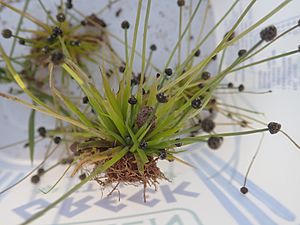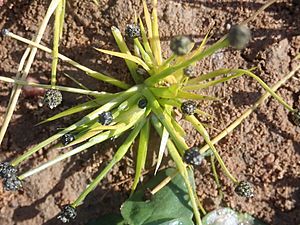Eriocaulon australasicum facts for kids
Quick facts for kids Eriocaulon australasicum |
|
|---|---|
 |
|
 |
|
| Conservation status | |
| Scientific classification | |
| Genus: |
Eriocaulon
|
| Species: |
australasicum
|
| Synonyms | |
|
Electrosperma australasicum F.Muell. |
|
Eriocaulon australasicum is a special plant. It is often called the southern pipewort or austral pipewort. This plant is a type of monocotyledon (a plant with one seed leaf). It belongs to the Eriocaulaceae family. You can find this plant in Australia. It grows in Victoria, South Australia, and New South Wales. Sadly, it is an endangered species.
Contents
What Does Eriocaulon australasicum Look Like?
Eriocaulon australasicum is a small plant. It lives for only one year. It grows partly in water, so it is called a semi-aquatic herb. It has a bunch of long, thin leaves at its base. These leaves are about 20–50 mm long and 1–1.5 mm wide.
Its flowers grow in small heads. These heads are shaped like eggs or small balls. They are about 3–4 mm wide. The flowers are protected by leaf-like parts called bracts. The fruit of the plant is smooth. It has three small sections, and each section holds one seed.
This plant likely needs to be covered by water for a time. This helps its seeds in the soil to sprout. The plants start growing in shallow water. This water is usually up to 20 cm deep. They grow best when the water is clear. They also like soil with lots of natural material. The plants quickly make flowers and seeds. This happens as the water levels drop and the ground dries out. We do not know much about how many seeds it makes. We also do not know how long the seeds can stay alive in the soil. This plant does not seem to grow new plants from its roots or stems.
Where Does Eriocaulon australasicum Live?
This plant grows in low areas that fill with water at certain times of the year. It also lives on the edges of swamps. These areas are usually on flat, clay ground.
How Was Eriocaulon australasicum Named?
The plant was first described in 1854. It was named Electrosperma australasicum by Ferdinand von Mueller. He found it in wet places near the Murray River. This was close to where the Murrumbidgee River joins it. Later in 1854, Friedrich August Körnicke moved it to the genus Eriocaulon. This is how it got its current name.
Why Is Eriocaulon australasicum in Danger?
One big danger to Eriocaulon australasicum is climate change. This plant lives in places that get wet only at certain times of the year. It probably needs to be covered by water for its seeds to grow. With climate change, these places might not get wet as often. This means there will be fewer places for the plant to live.
Another danger is animals eating and stepping on the plants. This happens with sheep in South Australia. Rabbits might also be a problem in Victoria.
What Is Being Done to Help?
People are working to protect Eriocaulon australasicum. In Victoria, they are fixing fences. This stops sheep from eating plants in the Little Desert National Park. They are also moving a road for cars. This helps to protect the plants from being disturbed by vehicles. Also, programs to reduce fire risk in parks are being changed. This is to make sure they do not harm the places where Eriocaulon australasicum grows.



